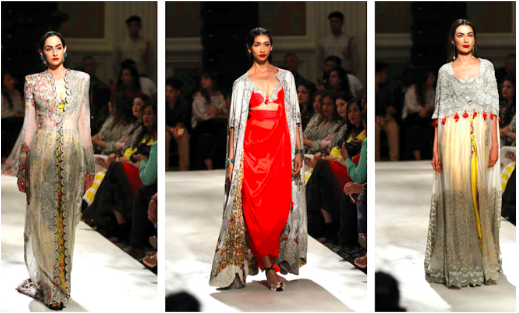Open the Secrets of Ageless Eastern Put On
Discovering the enigmatic realm of timeless Eastern wear explores a world where virtuosity, background, and society merge to create garments that go beyond plain textile and string. The complex tapestry of tradition interwoven with modern components uses a glance right into a globe where every stitch narrates, every theme an icon of value. Introducing the keys behind these productions introduces a tapestry of heritage waiting to be unraveled, welcoming one to trip with the spiritual beauty and aura of Eastern fashion.
Background of Eastern Style
The background of Eastern fashion dates back centuries, reflecting the rich social heritage and practices of varied areas across Asia. Each area boasts its special designs, fabrics, and designs that have been influenced by variables like environment, faith, social condition, and profession routes. eastern wear pakistan. As an example, the elaborate silk garments of China symbolize style and sophistication, while the vivid saris of India showcase a kaleidoscope of shades and patterns.
In Japan, the kimono has been an icon of tradition and refinement for generations, with various designs put on for various celebrations. The hanbok in Korea represents the country's ingrained personalizeds and is still used during vital ceremonies. The history of Eastern style is a tapestry of development and practice, mixing ancient practices with modern-day impacts to create a dynamic and ever-evolving industry. Recognizing the beginnings of these iconic garments gives understanding into the cultural value and craftsmanship that remain to motivate contemporary designers worldwide.
Value of Standard Attire
Conventional clothes serves as a social symbol, symbolizing the values, beliefs, and heritage of areas in Eastern cultures. eastern wear pakistan. These garments are not simply items of textile but are symbolic depictions of the abundant history and traditions gave via generations. In Eastern societies, typical outfit plays a considerable function in ceremonies, festivals, and life, mirroring the social status, local associations, and even marital standing of people
The relevance of standard outfit exceeds visual appeals; it is a method for individuals to get in touch with their origins and express satisfaction in their social identification. Each garment, from the detailed sarees of India to the streaming hanboks of Korea, carries with it a story of workmanship, meaning, and significance that is deeply ingrained in the textile of culture.
In addition, standard outfit acts as a visual language, interacting stories of unity, accomplishment, and durability. By wearing these garments, individuals not only recognize their heritage but additionally add to the conservation and party of their cultural heritage.
Evolution of Eastern Embroideries
Eastern needleworks have an abundant background that spans centuries and have continuously advanced to integrate diverse cultural influences and react to changing imaginative trends. The advancement of Eastern embroideries can be traced back to ancient people where detailed styles were hand-stitched onto textiles using conventional methods.

Today, Eastern needleworks proceed to develop, mixing typical workmanship with modern-day layout perceptiveness to create timeless pieces that celebrate the beauty of multiculturalism and imaginative development.
Luxurious Fabrics in Eastern Put On
Extravagant textiles play a pivotal function in elevating the visual charm and top quality of Eastern wear, enhancing the overall appeal and class of conventional garments. Eastern wear is renowned for its luxurious materials that not just show the region's abundant cultural heritage yet also indicate sophistication and elegance.
In enhancement to silk, materials like chiffon, brocade, and velour are likewise generally included in Eastern wear. These elegant materials not only elevate the aesthetic allure of Eastern wear yet also guarantee a sense of improvement and elegance that transcends time.
Incorporating Eastern Fashion Today
In contemporary fashion landscapes, the combination of Eastern affects provides an unified blend of cultural heritage and modern looks. Developers and fashion enthusiasts alike are embracing the abundant tapestry of Eastern fashion, including typical components right into contemporary shapes and styles. From intricate needlework to luxurious fabrics and dynamic shades, Eastern fashion today offers a diverse series of options that accommodate a global target market.
One means Eastern style is making its mark in contemporary closets is via the adjustment of conventional garments such as the kimono, saree, or qipao right into everyday wear. These pieces, as soon as booked for special occasions, are currently reimagined in even more laid-back forms, permitting for their unification into everyday fashion choices. In addition, using conventional patterns and motifs in Western-style garments adds a touch of unique sophistication to contemporary clothing.

Verdict
To conclude, checking out the rich history, relevance, and advancement of Eastern fashion unveils an ingrained connection to heritage and values. The elegant textiles and complex embroideries of Eastern put on showcase the adaptability and eternity of conventional layouts. Integrating Eastern affects in contemporary style permits a blend of custom and innovation, developing a harmonious balance in between the past and the present.
Elegant fabrics play a critical duty in boosting the visual charm and high quality of Eastern wear, improving the overall allure and refinement of standard garments. Designers and fashion fanatics alike are embracing the abundant tapestry of Eastern style, more helpful hints integrating typical elements right into modern-day silhouettes and designs. From intricate embroidery to glamorous textiles and dynamic shades, Eastern style today offers a diverse variety of options that cater to an international target market.
One method Eastern style is making its mark in contemporary closets is via the adaptation of conventional garments such as the robe, saree, or qipao into everyday wear. The glamorous textiles and detailed embroideries of Eastern wear showcase the adaptability and eternity of standard layouts.